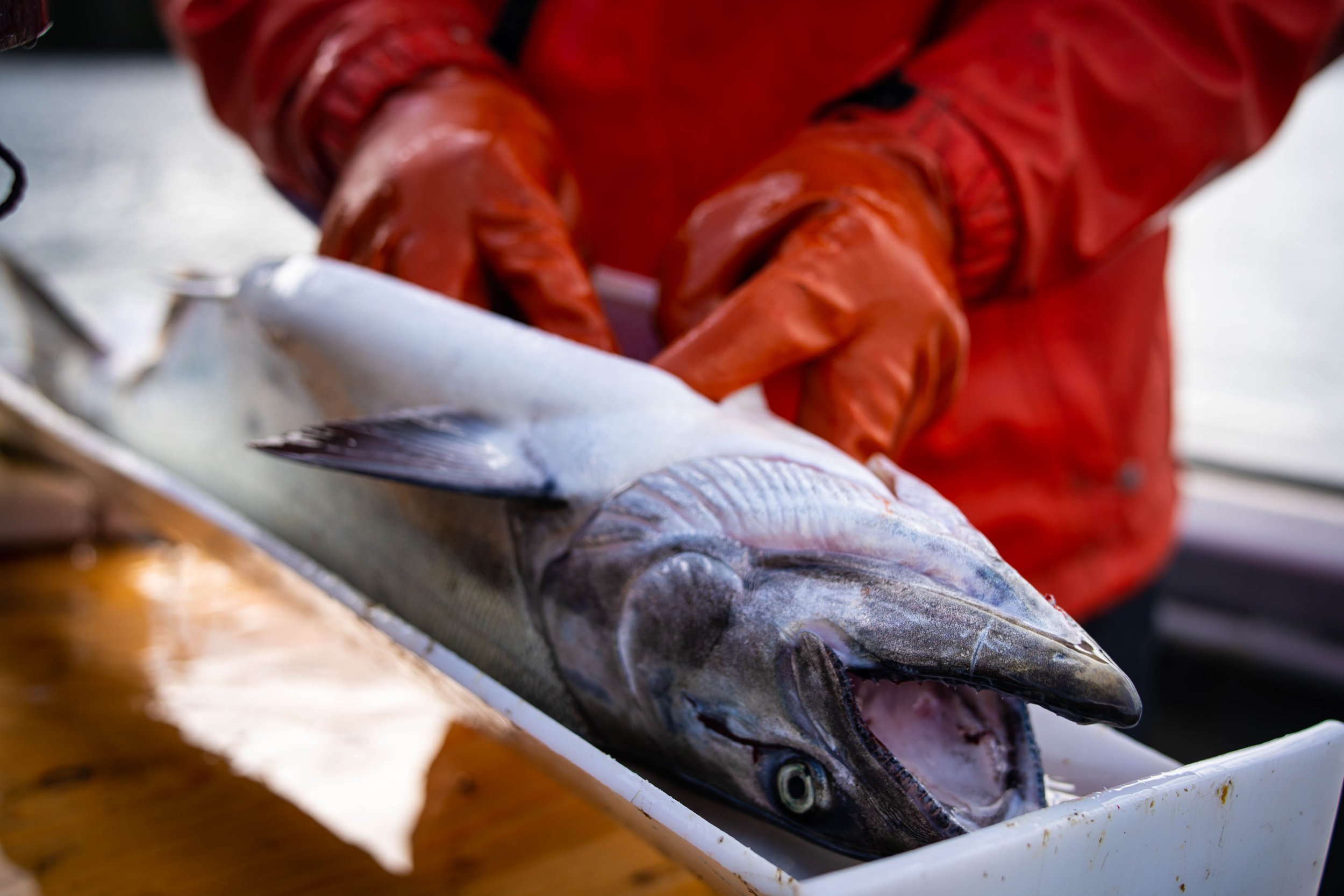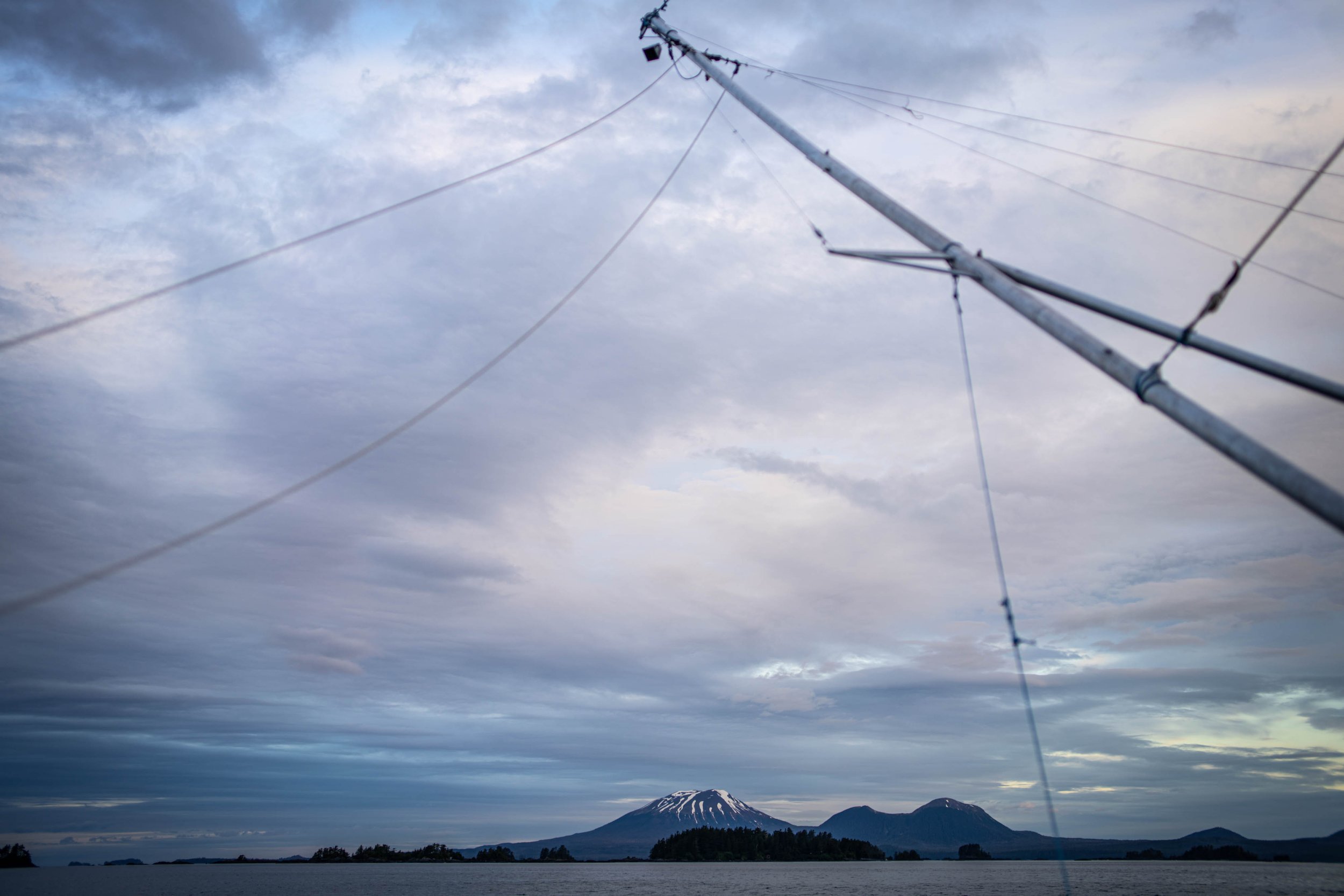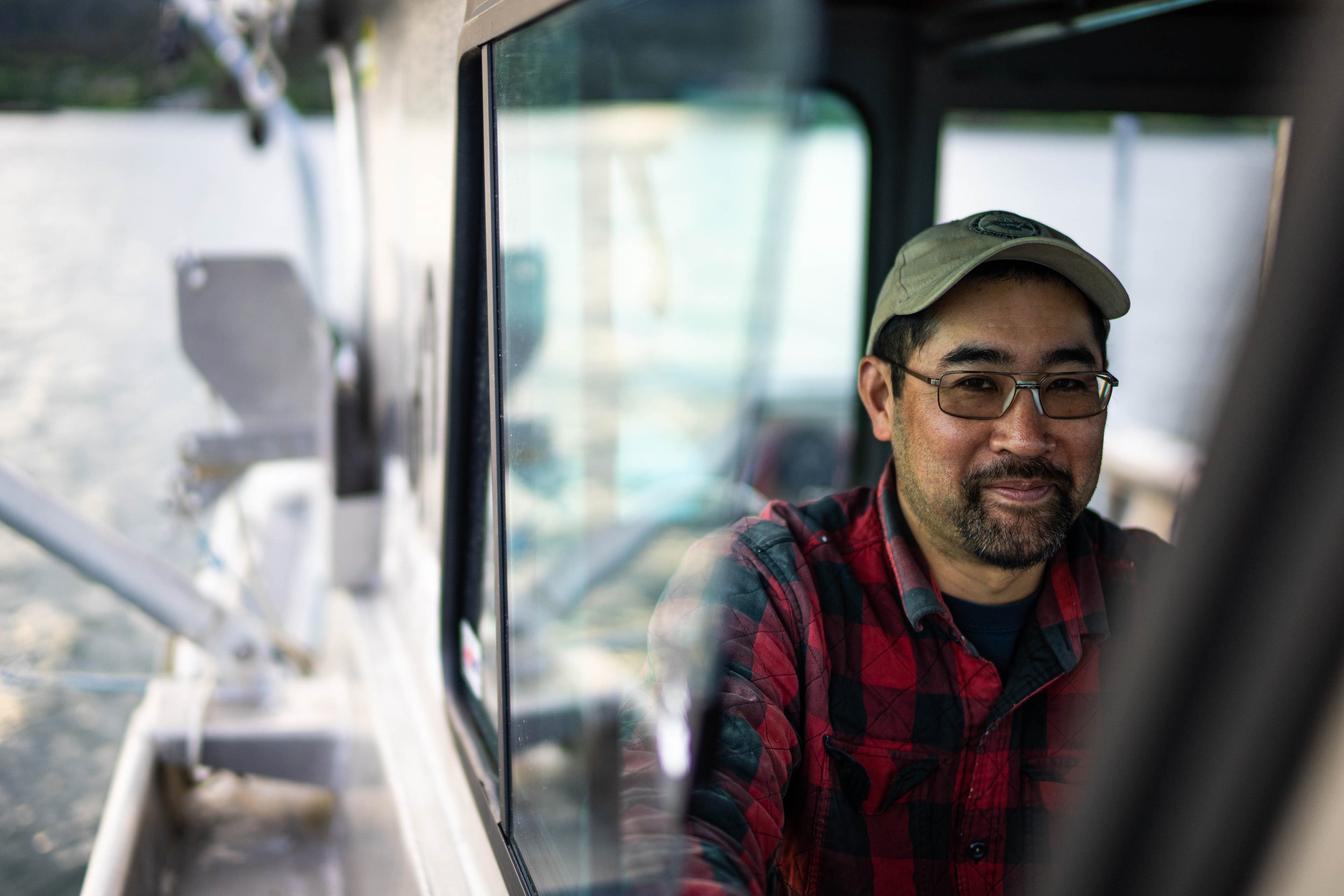Tad Fujioka
Southeast Alaska trollers are threatened by a misguided lawsuit from the Washington-based Wild Fish Conservancy, which alleges that this small-boat, family-owned fishery is negatively impacting Southern Resident Killer Whales.
The lawsuit ignores and distracts from the real causes of killer whale decline in the Salish Sea, which are far closer to home: urban and industrial development, contamination, and dams.
Trolling is a small-boat, sustainable, family-owned hook and line fishery that has an 85% residency rate in Southeast Alaska and a big presence in small communities.
These stories are from spring of 2023. In August 2024, the 9th U.S. Circuit Court of Appeals overturned a District Court decision that could have temporarily halted troll fishery, ruling that the lower court had “abused its discretion.”
Tad Fujioka and his daughter fishing together in 2020. Photo by Rafe Hansen.
“I’ve been sportfishing ever since I was old enough to hold a pole. I think I caught my first king salmon when I was about five years old, and I’ve continued to catch king salmon every year since.
When my oldest daughter was born, she had a medical condition that left her very vulnerable to lung infections. The doctor that sent us home said ‘Whatever you do, keep her out of a group daycare situation since her lungs haven’t developed the way she should have. As much as possible you should keep her isolated from other people, particularly other little kids.’
At the time I had a regular office job doing engineering work. My wife and I both cut our hours back to half time, so that one of us could be home with our daughter all the time.
When it was my turn to be home with her, it was - what can I do with you? I can’t take you to town, we can’t hang out with friends, but I can take you fishing.
So, I put her in a front pack and we went sportfishing quite a bit that first year and a half. There was good lingcod fishing that first fall. And there was particularly nice weather the following summer, with lots of king salmon close to town. At some point I remember flipping through my boat log and realizing that I’d been out in the boat more than 100 days in the past year- mostly with my daughter.
I thought hm, well, if I’m going to be fishing this much, maybe I ought to get a troll permit, and I can make some money doing this. That was 2010 and I have been trolling ever since.
There’s not a lot of safe space for a toddler on a small commercial fishing boat, so that first year I put my daughter in a fish tote; they are about the size of a playpen and typically used for storing fish and ice. She’s been fishing with me intermittently ever since. Now she’s a teenager – a high schooler – and she has a much busier schedule than she did when she was an infant. But she still goes when she can.”
—Tad Fujioka, troller, Sitka resident, Chairman of the Board of Directors of Seafood Producers Cooperative
Photo by Bethany Goodrich
“I have an engineering degree from Caltech. I got into engineering because I like problem solving… and I find when I’m trolling, I’m solving problems all day long. Some of the problems are probably my own fault - if I had done things right in the first place they wouldn’t have come up - but I’m able to react, and address the things that need fixing. When I am trolling, I am constantly analyzing data in various forms- that’s something that engineers are used to doing. When you are on the water, you’re looking at data in real time. What you see out the window, what you are catching- or not catching, what you’re hearing from your friends about their catches; the weather forecast, stage of the tide, fish prices, Fish & Game’s regulation changes or anticipated changes all influence your decisions. Trolling has been a real good chance to apply my data analysis and problem-solving skills. I develop more solutions in a day of fishing than I did in a week of engineering.
I like that there are so many choices involved in trolling. There’s an intellectual aspect that really appeals to me personally. Every spread (leader) that you put down - is this the lure I want here? What color, what size? How big of hook? How long a leader? How far apart should the spreads be? There are all sorts of choices you make just in gear selection. Then there is how deep to fish? How fast to troll? And of course, where to fish? It’s enough to drive you nuts sometimes, but it keeps it interesting.
That first year I trolled in a 24-foot open skiff. It didn’t have a cabin, just had a windshield. I put a Honda power pack on it to drive a set of power gurdies, and went trolling for the first time. Without an auto pilot I learned that if I let go of the steering wheel for more than 15 seconds the boat would “walk” itself into a hard turn to port. My first “autopilot” was a rope with a hook on it to hold the wheel in place. In a small boat, you’re very limited to what weather conditions are safe, but I could at least see the potential of the fishery. On the days when the weather was cooperative and I didn’t get the gear tangled up, I was catching as many fish as the established trollers.
After a couple more years I decided to leave my engineering shore job and turn to trolling as my primary job. So, I got a slightly bigger boat, and I’ve been trolling ever since- recently I moved up again to a 31-foot boat- still pretty small compared to most commercial fishing vessels.”
—Tad Fujioka, troller, Sitka resident, Chairman of the Board of Directors of Seafood Producers Cooperative
Photos by Bethany Goodrich
“Trolling is appealing as an entry level fishery. Because it is so inefficient a method in terms of time, it requires long hours on the water to make a good season. This means that the mix of labor and capital required to be a successful troller is tilted much more toward the labor side. That makes it economically affordable for beginning fishermen. Relatively low startup capital needs and the breadth of geographic opportunities available to the troll fleet – anywhere from Ketchikan to Yakutat- distance of more than 400 miles- make it very attractive for people in small, rural communities here in Southeast Alaska. Relatively speaking there are a lot more trollers in smaller places like Angoon, Hoonah, Kake, Pelican and Port Alexander than there are fishermen participating in the more capital-intensive fisheries.
If you want to live where generations of your family have lived and that happens to be a rural Southeast Alaskan village there aren’t very many things you can do to earn money there. Jobs are very limited, but anyone who wants to work can become a troller. People with such strong ties to their community, bonds that keep them home even though they could make more money in a larger community, are the kinds of people who inherently understand the need to harvest sustainably- just as their ancestors did. No government agency has to tell them to ensure that the fisheries that they are participating in now need to be there in the future for the next generation of fishermen- their children, grandchildren, etc. Without a sustainable fishery, the village economy can’t be sustained either. Fortunately, the mixed-stock Southeast troll fishery has proven to be sustainable for over 100 years. I am a troller because I want to be a troller, and I want to be able to be a troller for a long time and for others after me to be able to troll.
—Tad Fujioka, troller, Sitka resident, Chairman of the Board of Directors of Seafood Producers Cooperative
Photo 1 & 2 by Bethany Goodrich. Photo 3 Development around Seattle, WA. Photo 4 Tad Fujioka trolling in the F/V Sakura, his boat, in Southeast Alaska. Photo by Rafe Hansen.
“When we first heard about the Wild Fish Conservancy lawsuit a couple of years ago, we figured it would get thrown out of court, it was just so ridiculous — that a thousand trollers 900 miles away in Alaska would be considered more of a threat to killer whales in Puget Sound than the 4 million people living around the greater Seattle area that drive cars, flush toilets, spill chemicals, generate trash, refine crude oil, create electricity, build airplanes, etc. The State of Washington Department of Health says that the king salmon that spend their lives in Puget Sound are so contaminated with PCBs from nearby industries that you shouldn’t eat them more than twice per month. It is no wonder that the killer whales that eat these king salmon have some of the highest PCB concentrations ever found in marine mammals. Alaskan salmon in contrast contain virtually none of these contaminants, and the Alaskan orca that eat salmon right alongside Alaska trollers are healthy too, having doubled their population in the last few decades.
Even when Judge Jones eventually ruled that the National Marine Fisheries Service needed to more fully explain their conclusion that our fishery wasn’t a threat to the killer whales, it didn’t seem like that big of a deal. It reminded me of my 6th grade math teacher telling me that I needed to “show my work”. That meant that I had the right answer, but he just wanted to know how I arrived at it.
It wasn’t until last fall when Magistrate Peterson recommended that the troll fishery be closed while NMFS was in the process of “showing their work” that things got serious. This was such an extreme consequence, so far from any reasonable prediction of what NMFS’s final report was likely to conclude. The Southeast Alaska troll fishery is well over 100 years old. The sustainability of the fishery has long been proven – especially since our catches now are limited by international agreement to some of the lowest ever, and the king salmon stocks that we harvest are more abundant now than they were when stock health was first formally measured in the early 1980s.
At this point, there have been so many things about this lawsuit that just don’t make sense. Fellow trollers and other concerned citizens routinely ask me, ‘What do you think is going to happen?’ All I can say is, ‘We passed the offramp to Common Sense about five exits ago. I never been on this part of the road, and I don’t know where we’re going.’”
—Tad Fujioka, troller, Sitka resident, Chairman of the Board of Directors of Seafood Producers Cooperative
Photo by Bethany Goodrich
The mixed stock fishery is really the most economically consistent, and therefore sustainable fishery. You get a lot of benefits from diversification, just like you would in a stock portfolio. Sure, you could invest entirely in one stock, but that’s not a strategy that any economic advisor would recommend. You’re better off investing in a diverse array of stocks so that when one goes down, the other goes up, and they balance each other out.
Similarly, that’s the strength of mixed stock fisheries. Weather patterns that are bad for one group of fish tend to benefit other fish. When one stock is weak, another stock will be strong. And the fishermen inherently target the stronger stocks. Fishermen will find the bigger schools more easily, and the bigger schools are easier to stay on. Runs that are doing well that year will get more effort directed at them. Importantly, it doesn’t take an accurate prediction by some biologist to tell you what stocks to target. In a mixed-stock fishery that just happens organically.
Single stocks, whether a corporation or a salmon population, are so much more volatile than a portfolio. This makes them very hard to accurately forecast. Even Warren Buffett doesn’t pick winning companies all the time, and the very best salmon forecasters with the best data available to them have an average error of 25-30%. Most can’t even do that well. The typical salmon forecaster has an average error of over 50%! If your forecast is 50% too high, your harvest will also be far too high. Mixed stock fisheries are much safer from a management standpoint, and much more consistent from a fisherman’s standpoint.
—Tad Fujioka, troller, Sitka resident, Chairman of the Board of Directors of Seafood Producers Cooperative
Photo by Bethany Goodrich
“I like trolling for a number of reasons. From a conservation standpoint, being able to release the fish you don’t want is a big plus. Being able to be species-specific in your technique is also a big plus. Gillnetters can be size specific, but generally they are not species specific. A troller, on the other hand, can target a particular species by changing gear, changing speeds and changing depths. With king salmon fishing closed for a majority of the summer for most of the last 30 years, that’s something we’ve had lots of time to practice.
Because trolling is so inefficient from a time perspective, catching a fish one at a time versus netting up large volumes of fish all at once, we have the time to take really good care of our fish. We pump the blood out of them, dress them, and ice them one at a time. That affects not just the shelf-life but how the fish tastes in the end. What the eater of the fish ultimately gets to enjoy is that extra care. Trollers are able to provide the highest quality fish possible. Hook-and-line fishermen can’t compete with net fishermen on volume, so we take incredible care of the fish that we do catch. Troll king salmon in particular are so special. They’re the most valuable salmon caught anywhere in Alaska.”
—Tad Fujioka, troller, Sitka resident, Chairman of the Board of Directors of Seafood Producers Cooperative
Photo 1 by Bethany Goodrich. Photo 2 Sitka Harbor
“I’m the chairman of the Board of Directors of the Seafood Producers Cooperative. It’s a co-op of about 400 or so fishermen. We built our processing plant here in Sitka. SPC is the largest buyer of troll fish in the state. The lawsuit and subsequent court rulings have made it very difficult for SPC to plan our season. How many tenders do we want to hire? How many workers do we need? What can we tell our customers who are trying to pre-order to meet their business needs? You can only tell people ‘We’ll get back to you’ so many times before they find other alternatives.
The State of Alaska and the Alaska Trollers Association have appealed Judge Jones’ ruling. If we win the appeal in the next few months, we’ll be fishing. Even if we don’t win by then, we’ve asked to be allowed to fish while the appeal is pending. We are hoping that the courts will give us that opportunity in time for the summer season. Those are two possible options to get us on the water. The third route would be for the National Marine Fisheries Service to publish an interim Incidental Take Statement (permit) in time for fishery to proceed while they are working on a permanent revision. With three possible routes, I’m crossing my fingers; I’m optimistic that we’ll be fishing.
In terms of the big picture, SPC’s uncertainties are way bigger than my personal uncertainties. That’s where I’ve been more concerned – for SPC. The destiny of the whole troll fleet, and rural Southeast Alaska is riding on SPC’s survival. At some point SPC had to make a decision and now we’ve committed to assuming that there will be a season. It would be even more of a disaster if we gave up and said ‘Well, I guess we’re not fishing,’ but were then allowed to fish, except we didn’t have the facilities to handle the catch.”
—Tad Fujioka, troller, Sitka resident, Chairman of the Board of Directors of Seafood Producers Cooperative
Photo by Bethany Goodrich
“I think it’s important to know how vital trolling is to rural Southeast Alaska. One of the reasons I got so involved with the Seafood Producers Cooperative, running for the board and then getting elected chairman, was because I saw how important trolling is to the economy of rural Southeast. The larger communities- Juneau, Ketchikan, and probably even Sitka, have a diverse enough economy that they could probably get along with a crippled troll fleet. But the smaller communities really need a healthy troll fleet to stay economically viable. There just aren’t that many job opportunities in our smaller villages. These are all fishing communities and have been that way since the first Alaska native people settled there.
I’ve met so many wonderful people in the troll community. Such goodhearted people.
We’re competitors on the water, but back on shore – we all work for the greater community. This isn’t the first threat I’ve seen bring the fleet together, but it has been a powerful unifier. There are a lot of really, really good people in the troll fleet. It’s been gratifying to see such a high caliber of individuals that I’m working with and working for.”
—Tad Fujioka, troller, Sitka resident, Chairman of the Board of Directors of Seafood Producers Cooperative















